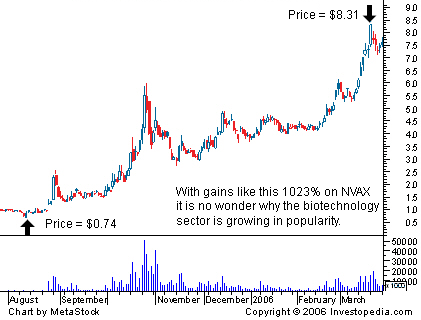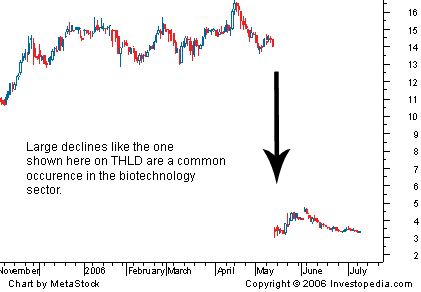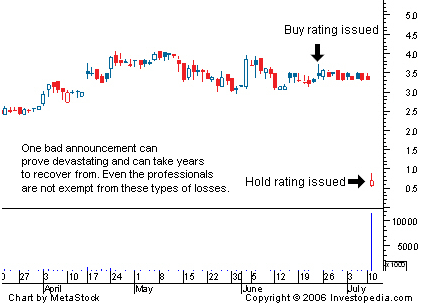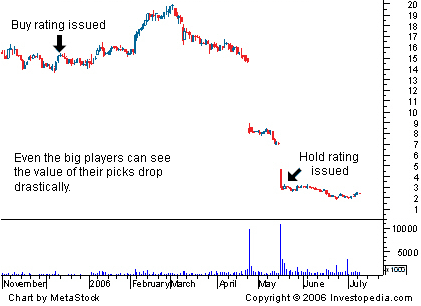Many traders dream of the day they can close out their positions and realize that one big gain. You probably have heard stories about novice traders that build up their trading accounts from mere thousands into millions. Biotechnology is a sector where traders seek out these such huge profits. For smart traders, this sector can present an incredible area of opportunity, but for those who are not willing to do their homework, it can be a train wreck waiting to happen. In this article, we'll use real-life examples to illustrate why this sector can be so appealing, and what issues you should consider before putting your capital at risk.
The Big Win
There are few sectors in the market that see small single-product companies go from having tiny market capitalizations to having a worth over hundreds of millions practically overnight. The business of curing diseases can be a lucrative one, and investors will jump on the bandwagon for any stock that shows the promise of a big breakthrough. For example, as you can see in Figure 1, Novavax Inc. (NVAX) rose from a low of $0.74 in August 2005 to a high of $8.31 in March 2006. This is equal to an amazing 1,023% in seven short months. With gains like this, it is easy to see why so many are anxious to put money into this sector.
The Big Win
There are few sectors in the market that see small single-product companies go from having tiny market capitalizations to having a worth over hundreds of millions practically overnight. The business of curing diseases can be a lucrative one, and investors will jump on the bandwagon for any stock that shows the promise of a big breakthrough. For example, as you can see in Figure 1, Novavax Inc. (NVAX) rose from a low of $0.74 in August 2005 to a high of $8.31 in March 2006. This is equal to an amazing 1,023% in seven short months. With gains like this, it is easy to see why so many are anxious to put money into this sector.
 |
| Figure 1 |
It's Not All Roses
You just can't plop down your $10,000 and come back in seven months to collect $102,300 always. Along with the opportunity to make huge gains comes the potential for some very devastating losses. Because most of the companies in this sector are relatively small, most with no more than two or three products, news releases about their clinical trials and/or concerning approval from the Food and Drug Administration (FDA) become the main factors deciding the direction of the company's stock. Companies in this sector live and die by these announcements.
For example, investors of Threshold Pharmaceuticals (THLD) saw the price of their shares travel to a high of $16.98 in mid-April 2006 only to fall to a low of $3 in mid-May 2006. The major fall was attributed to the termination of the company's clinical trials upon the FDA's request. The 82% drop in roughly one month is a good example of what can happen when a company releases this type of bad news.
Even worse, notice in Figure 2 how the stock gaps down. This means that you have no chance of cutting losses once you've entered the trade. For example, let's say that you bought the stock at around $15 and had a stop-loss order in for $13. In theory, the stop-loss should limit your loss to around $2 ($15-$13). In volatile markets like this, however, you can't limit your loss. Your order will get filled at the open price of $3, not the $13 you wanted. (For more insight, see Playing The Gap.)
 |
| Figure 2 |
The Story
Many investors get wrapped up in the story of a small biotech firm and convince themselves that the company's product(s) will revolutionize its industry. Some investors even place money into these types of companies simply because they believe that the complex products seem so impressive that they must work. It's not that impressive-sounding products can't be successful, but rather that it is extremely difficult for the average investor to get a handle on the probabilities of success for a drug. (To learn more, see Using DCF In Biotech Valuation.)
For example, an investor who is researching Micromet Inc. (MITI) on Yahoo!'s Financial page would read that "its drug development platform is based on its BiTE technology, an antibody-based format that uses the cytotoxic potential of T-cells. The company's principal product candidates include Adecatumumab (MT201), a recombinant human monoclonal antibody" (2006).
This might sound impressive, but do you have any idea what the company does? Perhaps those of you with doctorates in biology understand, but for the average Joe (or the average analyst), even understanding the product can be difficult. What this means is that you, the investor, are going to have to do a lot of homework to figure out exactly what the product is, what the company's strategic advances are and what risks are involved in the event that the product does not work. (For related reading, see Introduction To Fundamental Analysis and What Kind Of Research Do Investors Want?.)
Nobody Really Knows, Not Even the Big Guys
Since the companies in this sector can be very complicated, many traders will turn to large financial institutions for guidance. The buy and sell ratings made by these companies can be used as a tool to determine whether or not an investment decision should be made, but as you can see in Figure 3, they can be totally wrong. In our first example, an investment bank issued a buy rating on Valentis Inc. (VLTS) on June 23, 2006. Eleven trading days later, the company released bad news about its drug and the stock fell a whopping 79% in one day. What did the firm that issued the buy rating do? They downgraded the stock to a hold rating! It makes you wonder how poorly a company has to perform to get a sell rating. (For further reading, check out Analyst Recommendations: Do Sell Ratings Exist?, Why There Are Few Sell Ratings On Wall Street and Stock Ratings: The Good, The Bad And The Ugly.)
 |
| Figure 3 |
Another example of poor financial institution advice occurred on December 8, 2005, when a large investment bank issued a buy rating on DOV Pharmaceuticals Inc. (DOVP). At this point in time the price was approximately $15, but as you can see in Figure 4, this changed within the next few months as the stock dropped off and hit a low of $2.71. On May 17, 2006, the investment bank came out and (again) issued a hold rating, but this rating was not much help to investors as the stock dropped again, to a new low of $1.85 a month later.
 |
| Figure 4 |
Conclusion
The biotechnology sector is very exciting and can be very rewarding for those who remain cautious and do their homework. However, it is easy to get caught up in the dream of 1,000% gains, or the intriguing stories of how certain companies' products will change the world. It is important to realize that if you are aiming for huge gains in the biotech sector, you likely will encounter some bad trades that will leave you reeling at the reduction of the value of your account. We all know that investors make mistakes and, as shown above, even the big players can see their picks lose most of their value. If the big players can be wrong completely, so can you, so trade with caution and restraint. When it comes to investing in this high-risk sector, it may be wise to use only as much money as you can afford to lose.
By Casey Murphy,
Access Investopedia's Forex Advisor FREE Report - The 5 Things That Move The Currency Market
No comments:
Post a Comment